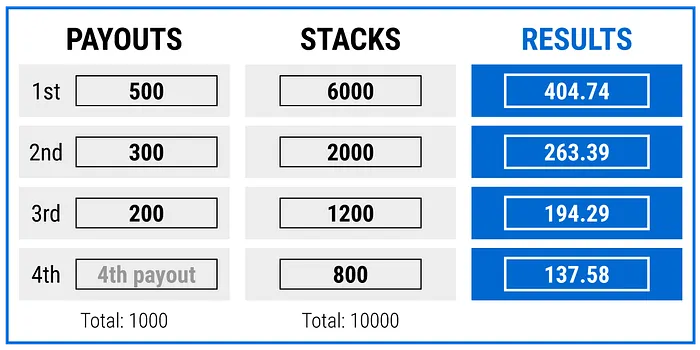ICM
ICM is an acronym for Independent Chip Model which is a calculation that allows players to convert a tournament chip stack into a monetary value of their equity, based on what’s left from the prize pool.
This page will explain ICM in greater detail, its importance, and how you should adjust your play when ICM considerations are needed.
What is ICM? The Independent Chip Model Explained
The first thing that you need to know is that the concept of ICM only exists in poker tournaments. ICM is not something to consider when playing poker cash games as the value of your stack remains the same. For example, if you are at a cash game table with $500 in front of you, your stack value is $500.
ICM essentially tells you what the real (monetary) value of your chips are while giving you a better understanding of the risk and reward in all stages of a tournament and is determined by two factors:
- The chip stacks of the players left
- Payouts
As it is just a mathematical model, which can be calculated with an ICM calculator, it ignores factors like a player’s skill or edge for example, and is the main reason why ICM is often the starting point of negations for a final table deal.
When is ICM important?
It is a common misconception that ICM only comes into play when the bubble is looming and at a final table. Very few people realize that ICM plays a role from the get-go.
ICM is an important concept to think about throughout the entirety of a tournament but do take note that it is especially more crucial in the late stages of events and should impact the decisions you make the further your progress.
How does ICM work in poker?
As mentioned, ICM considers two factors, the payout structure and the stack sizes of all remaining players. ICM combines the two variables and allocates a single value to each player.
Based on the chip stack sizes, ICM works out the probability for each player finishing in 1st, 2nd, 3rd… and multiplies those probabilities with the payouts for each position.
While it is complex to work out the probability of finishing in second or third place as this is when a computer is required, figuring out the chances of a specific player finishing in first place can be done by dividing the number of chips a player has by the total amount of chips in play.
What is an ICM deal/chop?
A simple ICM calculation example can be seen below. Let’s say you’re playing a $100 sit-and-go with 10 players. Each player has a stack of 1,000 and the payouts are $500 for first, $300 for second and $100 for third.
After a few hours, there will be some players who bust so let’s say that four players remain. At this stage, the remaining players may consider doing an ICM deal. An ICM deal is where payouts are determined by the monetary value of someone’s chip stack.
In this example, let’s say they have the following chip stacks:
- Player 1: 6,000 chips
- Player 2: 2,000 chips
- Player 3: 1,200 chips
- Player 4: 800 chips
To work out the monetary value for the stacks, enter the figures into an ICM calculator and you will get the following results:
- Player 1: 6,000 chips = $404.74
- Player 2: 2,000 chips = $263.39
- Player 3: 1,200 chips = $194.29
- Player 4: 800 chips = $137.58

If the players are happy with the numbers and share out the prize pool presented above, this is what would be considered an ICM deal.
What’s the difference between $EV and Chip EV?
Chip EV is the expected value in chips and refers to the net amount of chips that a particular decision profits or loses. Whereas $EV, which relates to ICM, is the monetary equivalent of the expected value.
It is important to know that there is no linear relationship between Chip EV and $EV. Simply put, double the Chip EV does not work out as double the $EV. You will also find out that some plays may expect to win you more chips on average but may also cost you real money over a large sample size.
ICM Strategy - How to adjust your play for ICM
In this section, you will find out how to adjust your play for ICM when you either have a short, middle or big stack. The strategies between these three positions differ as you will have to consider the ICM factor when in these spots.
Short-stack ICM strategy
If you have a short stack in a poker tournament, you face the smallest amount of ICM pressure as you simply have the least to lose. This means you can up and ante and play aggressively with the hopes of spinning up your stack.
Medium-stack ICM strategy
While having a middle-of-the-road chip stack sounds like a good place to be in, you can often encounter many headaches as you are forced to play tight ABC poker. This is because it is terrible for a player with a middling stack to be eliminated before the low stacks bust.
This is especially true when at the final table, where most of the prize pool is awarded. These medium stacks have the most to lose.
Let’s say you have a middling stack with nine players remaining and you have a low pocket pair in the big blind. The short stack has one big blind and is forced all-in on the next hand. Now, the chip leader moved all-in preflop and you’re in a bit of a bind.
Big-stack ICM strategy

If you are absolutely crushing in a particular tournament and have become one of the chip leaders, you’re in a great position.
As a big stack, you get to put the pressure on the short-stacks who are just looking to make the money or survive to the next pay jump.
In addition to this, you can also bully players with middling stacks as those players will be forced to play tighter. Those with an average stack will be waiting for the shorter stacks to bust and they’re confined to playing tighter due to ICM considerations.
If you find yourself in this scenario, then you should raise first in with a wider selection of hands as well as expand your three-betting and shoving ranges as this will force the middle-of-the-pack players to fold a good portion of their ranges.



